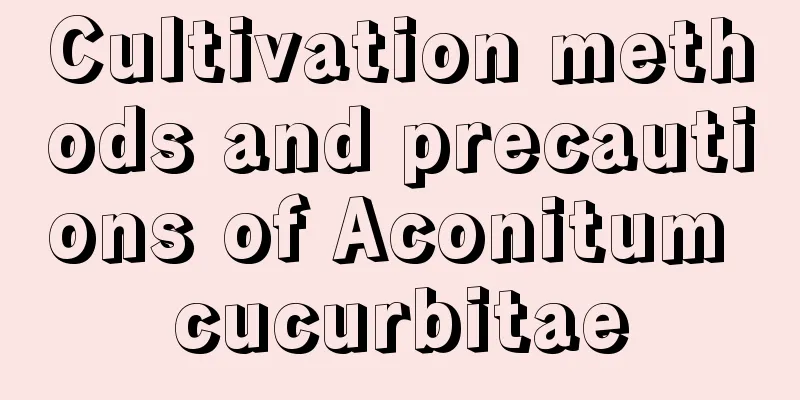Cultivation methods and precautions of Aconitum cucurbitae

Root PruningRoot pruning needs to be done twice. The first time is in early April, when the seedlings should have grown four or five leaves. First, dig the soil in the nearby area to the mother root position and remove some of the Aconitum. When the seedlings are growing well, you can leave 2-3 Aconitum, but when the seedlings are still small, only one is needed. The interval between the second and the first time is not long, and it should be done in mid-May. At this time, the soil may need to be dug to 13-16cm. The newly grown small Aconitum also needs to be removed, and the roots of the large Aconitum that have been preserved before should also be removed, but be careful not to damage the remaining roots, otherwise it will affect its growth. TipBefore each fertilization, pinch off the top parts. After another 3-5 days, when you see axillary buds growing on the plant, take them down directly. This will ensure a certain yield. weedingThis plant needs careful care when planting. Weeds should be pulled out immediately when you see them. In summer, everyone may think that the weather is too hot and the plants need too much water. Actually, it is not. This period is the time when water cannot accumulate. Once water accumulates seriously, it may cause the death of the entire plant. FertilizationWhen the seedlings are about 6cm tall, top dressing must be carried out, and organic fertilizer can be used at this time. The second application of fertilizer should be after the first root pruning, but do not apply it directly under each plant, but place it between two plants. The third time should naturally be done after the next root pruning. Destruction of diseased plantsIf you encounter diseased plants, do not leave them in the ground; pull them out and burn them directly. Otherwise the disease will spread. At the same time, you should pay attention to the timely use of medicines to eliminate the germs more thoroughly, so you should pay attention to it. |
<<: Main Varieties of Climbing Roses
>>: The difference between Rieger Begonia and Glass Begonia
Recommend
Is the osmanthus tree a shade-loving or sun-loving plant?
Does the osmanthus tree prefer shade or sun? The ...
How to prune the juniper bonsai
When is the best time to prune juniper bonsai? Th...
The difference between spider silk, hairy silk and red silk
The difference between spider silk and hairy silk...
The Buddha's affinity with the horse chestnut tree
The shape of the horse chestnut The sal tree is a...
How to prune the golden jade flower
When to prune the golden jade flower The pruning ...
What to do if the leaves of Gloxinia wilt
1. Solutions 1. Fertilization Half of the reasons...
Why is the water for growing lotus always turbid?
Why does the water always become turbid when grow...
How to grow and propagate Benbatis succulents
1. Loose soil As a succulent plant, Benbatis is s...
How to grow five-color plum in autumn
1. Proper pruning Autumn is its growing season. I...
The difference between wild lily and lily
1. Differences in stems Some of the stems of wild...
Feng Shui Application of Mandala
Feng Shui Placement of Mandala in Home In fact, M...
Is jasmine poisonous? Can jasmine be grown in the bedroom?
1. Is it poisonous? Jasmine is a common flower. A...
How to raise Qingli
Watering Compared with other plants, Qingli is a ...
How to grow potted plum blossoms well
How to cultivate plum blossom in potted plants 1....
How to save onion seeds
Green onion seeds introduction Onions have seeds....









